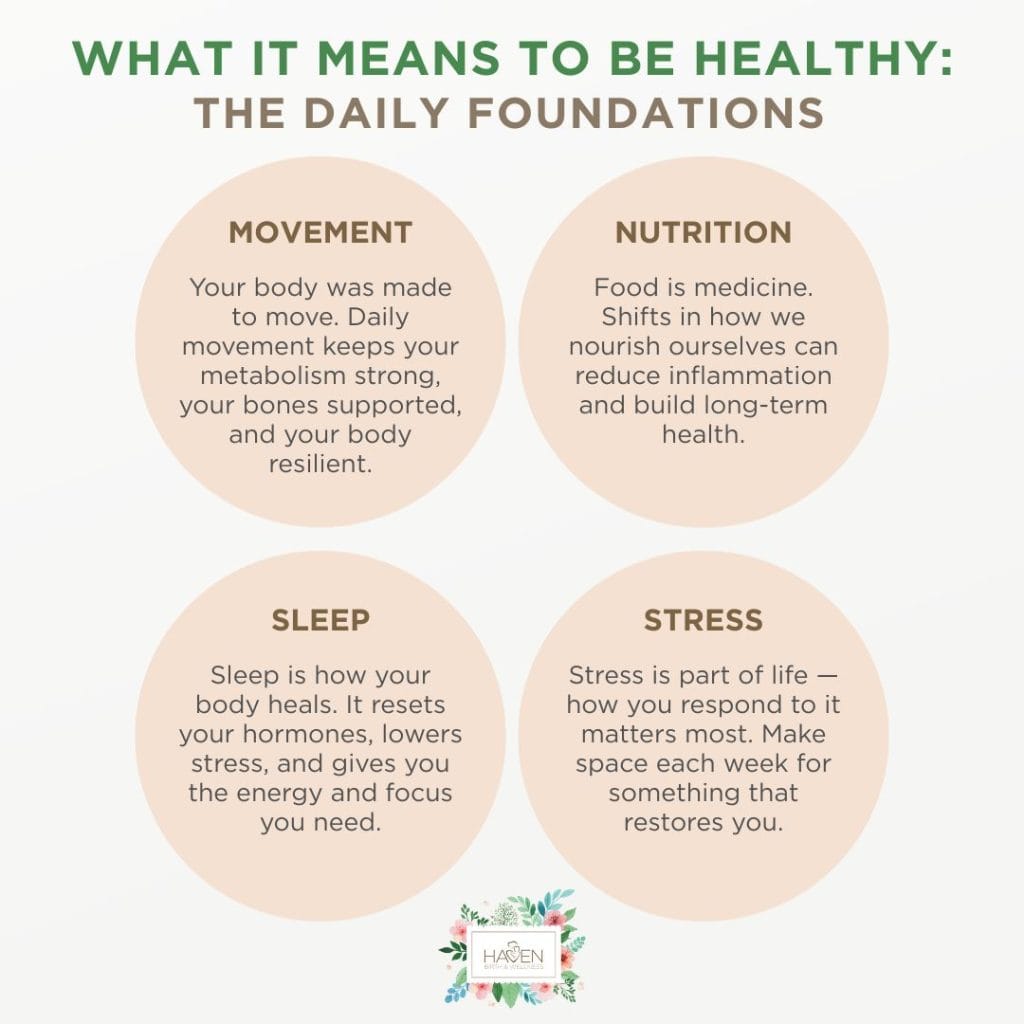

What does it mean to be healthy?
It’s a question that goes far beyond simply not being sick. True health encompasses your ability to live life fully and joyfully.
To me, as a family nurse practitioner, being healthy means being able to do what you love without being held back by symptoms. It means being able to move your body — walk, run, stretch, lift — without pain or fear of injury.
It’s having a sense of trust in your immune system to fight off illness and help you recover well. And it’s feeling emotionally steady, getting truly restorative sleep, and having the mindfulness to recognize when you need a change or reset in your life.
It’s not about chasing perfection. It’s about paying attention, checking in, and taking small steps to support your body and mind.
Let’s talk about what it means to be healthy, some ways we can assess health, and the everyday habits that shape it.

Diagnostic Markers: 5 Key Tools to Evaluate Metabolic Health
As healthcare providers, we look at specific diagnostic markers to evaluate your metabolic health and overall well-being. These aren’t just numbers on a lab report — they’re windows into how well your body is functioning.
Below, I’m sharing five of these key tools. I don’t necessarily run these tests at every visit, but I always have them in mind if we need to look a little deeper. The results provide great insights into your overall wellness and where we might want to support it more intentionally.
Fasting Blood Glucose and Insulin
What It Is: Fasting blood glucose is how much glucose (sugar) remains in your blood after 8+ hours of fasting. Fasting insulin shows how much insulin is present in your blood after 8+ hours of fasting. While technically different tests, these metrics measure two sides of the same coin.
How It’s Measured: You’ll have a simple blood draw in the morning after at least 8 hours of fasting — meaning nothing but water (or black coffee or tea) beforehand.
Ideal Results: For fasting blood glucose, “normal” is less than 100 mg/dL and “optimal” is less than 80 mg/dL. For fasting insulin, normal varies widely. As a functional medicine provider, I consider less than 10 uIU/mL “normal,” and closer to 5 uIU/mL as “optimal.”
Why It Matters: Both tests show us how well your body is regulating your blood sugar. I might recommend these labs if I’m concerned about issues like insulin resistance, PCOS, or changes around perimenopause or menopause.
Additional Notes: Continuous glucose monitors can be helpful tools for people with blood sugar issues, but they’re not for everyone. While they may increase awareness, they can also lead to hyper-fixation around food, which we want to avoid.
Triglycerides
What It Is: Triglycerides are a type of fat in the body that tends to rise with diets high in processed or fast foods.
How It’s Measured: We measure triglycerides with a simple blood test, again after 8+ hours of fasting. This test is part of a standard lipid panel.
Ideal Results: Under 150 mg/dL
Why It Matters: Elevated triglycerides increase your risk for cardiovascular disease, including stroke and heart attack, by causing inflammation and damage in your arteries over time.
HDL
What It Is: HDL, or high-density lipoprotein, is usually referred to as “good” cholesterol, meaning higher levels (within reason) are actually beneficial.
How It’s Measured: Another part of a standard fasting lipid panel, HDL is measured via a blood draw.
Results: Above 50 mg/dL
Why It Matters: HDL helps your body clear out excess cholesterol and protects against plaque buildup in your arteries, leading to lower risk of heart disease.
Additional Notes: To support healthy HDL levels, aim for eating healthy fats and foods rich in omega-3 fatty acids, like avocados, olive and avocado oils, nuts, and seeds.
Blood Pressure
What It Is: Blood pressure tells us how hard your blood is pushing against the walls of your arteries as it flows.
How It’s Measured: We usually measure blood pressure using a blood pressure cuff on your arm. It records a top number (systolic) that represents the pressure during a heart beat and a bottom number (diastolic) that represents pressure in between beats.
Results: Less than 120/80 mmHg
Why It Matters: High blood pressure signals inflammation and constricted blood vessels, and can cause cardiovascular issues over time. Low blood pressure (less than 90/60 mmHg) can also cause problems or indicate an underlying health issue.
Additional Notes: Your blood pressure isn’t static; it changes depending on what you’re doing and feeling. When you’re moving, excited, stressed, or upset, your blood pressure rises. When you’re at rest, it falls. It’s important to know that blood pressure recommendations are for resting blood pressure, which is why I usually take this vital at the end of a visit, after you’ve had time to settle in and relax.
This is also why I don’t diagnose high blood pressure based on one office reading. Instead, I often recommend clients keep a log of their own blood pressure for a week, either using a home blood pressure cuff or one of the handy machines at Walmart or a drug store. Just be sure to give yourself time to relax before starting, sit down with both feet (uncrossed) on the floor, and keep your arm resting at about heart level in front of you.
Low blood pressure can be due to dehydration. In some cases, factors like a specific medication or iron deficiency could cause it. If your blood pressure is consistently low, even with good hydration, I may refer you for further evaluation.
Waist Circumference
What It Is: Waist circumference is the measurement in inches of the distance around your waist.
How It’s Measured: A flexible measuring tape encircles your waist — about halfway between your bottom rib and belly button — while you stand.
Results: Under 35 inches in women (or less than 0.85 waist-to-hip ratio)
Why It Matters: This measurement gives us a sense of how much fat (adipose tissue) is present around your vital organs and how that might affect your risk for metabolic dysfunction.
Additional Notes: Waist circumference often increases with the hormonal shifts of perimenopause and menopause. While this isn’t a measurement most providers take in the office, it’s a useful marker for monitoring your own metabolic health.
What It Means to Be Healthy: Influencing Factors
While these markers give us a snapshot, what really shapes health day to day is how we’re living in our bodies. That’s the part I love talking through with my clients because it’s where they get to take their health into their own hands.
Movement
Your body was made to move. Whether it’s a walk around the block, a run at the track, some pelvic floor exercises, or a strength training session, some form of daily movement helps your metabolism, supports your bones, and keeps your body resilient. As we age, having strong muscles also supports our bodies’ fat-burning ability and stress response.
Nutrition
Food is medicine. It either feeds inflammation or fights it, and small shifts in how we nourish ourselves create lasting changes over time.
Limiting added sugar plays a big role in that equation. The daily recommended limit for dietary sugar is 25 grams, which can add up quickly. It’s easy to forget that even “natural” sugars like honey or maple syrup still count as sugar!
Sleep
Sleep isn’t just rest; it’s repair. It’s how your body resets hormone levels, lowers cortisol, heals tissues, strengthens memory, supports creativity, and restores your ability to focus. We need sleep for emotional and physical resilience!
For most people, creating a calming bedtime routine and letting your circadian rhythm establish itself makes a big difference. If you’re curious to learn more, I recommend the book Why We Sleep by Matthew Walker.
Remember, sleep looks different in every season of life. If you’re in the infant or toddler phase, for instance, give yourself grace and simply aim for consistency when you can.

Stress
Stress is part of life, and we’re never going to fully get rid of it. While we may be able to remove certain unnecessary stressors, what matters most is how we respond to stress.
One major way to balance stress and our response to it is to intentionally choose life-giving activities at least once a week — movement, time alone, time with friends, creative expression, spiritual practice — whatever helps you rejuvenate. Moms, in particular, tend to put themselves last, but I encourage you to find something that fills your cup weekly.
What Does It Mean to Be Healthy? Final Thoughts
So, what does it mean to be healthy? It means having the energy and resilience to live your life fully, feeling confident in your body’s ability to handle challenges, and maintaining emotional balance through life’s ups and downs.
Health isn’t about perfection. It’s about creating sustainable habits that support your body’s natural ability to thrive. The five diagnostic markers I mentioned let you see when your body is thriving — or struggling. When you understand what it means to be healthy in all these dimensions, you can make informed choices that truly serve your well-being.
If you’re not sure where to begin, start with a wellness visit. Come in once a year (to Haven or your primary care physician), and we’ll take a look at how you’re doing. It’s a simple, grounding way to get a pulse on your health and to make sure you’re on a path that supports the life you want to live!

Katherine Jacobs is a board-certified Family Nurse Practitioner with nearly two decades (17 years) of experience in pediatrics and women's health, along with specialized training from The Institute of Functional Medicine. She focuses on identifying the root causes of illness and guiding patients toward optimal health through personalized, holistic care. With a commitment to integrating lifestyle choices and environmental factors into her treatment plans, Katherine is dedicated to empowering her patients on their wellness journeys. Outside of work, she enjoys outdoor adventures, baking, and spending time with her family.
